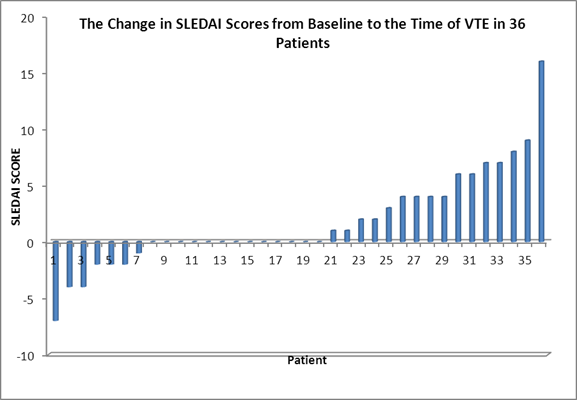Session Information
Session Type: Abstract Submissions (ACR)
Background/Purpose: Venous thromboembolism is a recognized complication of systemic lupus erythematosus (SLE). The role of antiphospholipid antibodies (aPL) in thrombogenesis is well documented; much less is known about the potential for an increased risk of thromboembolic disease in the absence of these markers. Inflammatory stimuli are prothrombotic, with apoptotic endothelial cells identified as a potential trigger through tissue-factor dependent pathways. We aim to determine whether venous thromboembolic events (VTE) in patients with SLE correlate with periods of enhanced disease activity.
Methods: A retrospective chart review was performed on 837 patients enrolled in the Michigan Lupus Cohort to identify patients diagnosed with VTE. Patients satisfied ≥4 ACR criteria for SLE. Diagnosis of VTE was defined as a positive venous doppler, CT scan of the thorax, or high probability VQ scan.
Risk factors for VTE were noted including: use of oral contraceptives within 3 months of the event, pregnancy/ 6 weeks postpartum, surgery within 3 months, smoking, inherited thrombophilia, malignancy, and the presence of nephrotic-range proteinuria. We also noted the presence of aPL positivity (defined by positive lupus anticoagulant or antibodies to cardiolipin or beta-2 glycoprotein-1 IgG, IgM or IgA at >99% percentile of assay).
Disease activity was measured by the Systemic Lupus Disease Activity Index (SLEDAI).
Markers of disease activity at the time of VTE were recorded using the closest SLEDAI score within 3 months before, or up to 1 month after the event. Comparisons were made between the SLEDAI score at the time of the event and a baseline SLEDAI collected up to 12 months prior to the event for each patient.
Results: 72 patients were identified as having sustained a VTE (8.6%). Of these patients, 36 had serial SLEDAI data available. The most frequently detected confounding risk factors were recent surgery (30.6%; p= 0.012) and the presence of aPL (25%; p= 0.033). If aPL positivity was required to be present on two separate occasions, this no longer became a statistically significant association.
There was a significant association between VTE and disease activity, with a mean increase in SLEDAI score of 1.72 at the time of event (p= 0.021; 95% CI 0.274-3.471).
Figure 1. The difference for each patient between the SLEDAI score at the time of VTE compared with the score 4-12 months previously.
Conclusion: Our results show a statistically significant association between disease activity and VTE, independent of the presence of aPL. This has implications for the management of patients with active SLE, including decisions regarding the safety of estrogens for contraception and the threshold for anticoagulation in high-risk situations such as pregnancy. It may also lend clinical support to a growing body of basic science research that suggests an association between inflammation and thrombosis.
Disclosure:
R. Jan,
None;
E. E. Lewis,
None;
T. T. Lu,
None;
E. Siegwald,
None;
W. J. McCune,
None.
« Back to 2012 ACR/ARHP Annual Meeting
ACR Meeting Abstracts - https://acrabstracts.org/abstract/there-is-an-association-between-disease-activity-and-risk-of-thromboembolism-in-sle/

